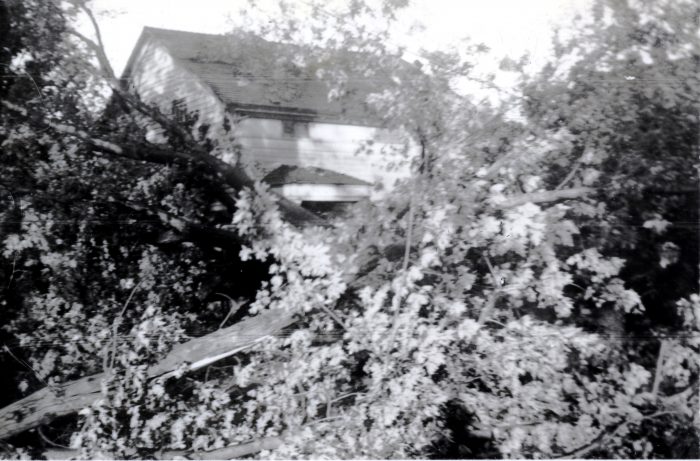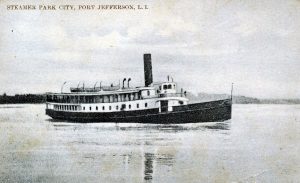History Close at Hand: The harrowing tale of the ‘Long Island Express,’ the ’38 hurricane that rocked the Island

By Beverly C. Tyler

Eighty-five years ago, on Wednesday, Sept. 21, 1938, just past noon, a tidal wave swept over Fire Island and the Long Island South Shore, the advance wind and waves announcing the arrival of a hurricane, later named the “Long Island Express.”
It swept across eastern Long Island and continued across Long Island Sound to have even greater destruction and loss of life in southern New England.
That evening at 10 p.m., my grandmother, Edith Tyler, then Setauket’s postmaster, wrote on a penny postcard describing the storm’s local impact. She postmarked the card the following morning and sent it to my father in Brooklyn.
Edith wrote, “Beverly – Did you have a storm today? We have had a northeaster followed by west wind – no lights, telephone – and what a wreck Setauket is – about a dozen trees down. … The green was a wreck – 25 trees from here to Catholic Church down – 100 they say down at Wide Water … mail didn’t get in until 8 p.m. … Jimmy says the Bridgeport boat hasn’t been reported since 2 p.m. Never saw anything like it before – tree blew down on Brennan’s house – wind changed and blew it off … general destruction all around – Mother.”
The hurricane was the subject of Three Village Historical Society oral history interviews. A few were printed in the society’s journal, “The Three Village Historian.”
East Setauket’s Forrest West described the hurricane. “I was commuting in those days on the [Long Island Rail Road] from East Setauket to Brooklyn,” he said. “On my usual afternoon train that day, my head was buried in my newspaper. Only at Huntington did I look up briefly. Noting people braced into the wind and umbrellas being blown inside out – or away – I mildly noted to myself that there was quite a wind blowing and returned to my paper.”
He continued, “Nearing Smithtown, I laid my paper aside and noted that we seemed to be held up going into the station. Held up we surely were for the remainder of the trip, as trees had to be cleared from the tracks. The immensity of the storm was finally getting into my consciousness. Arriving hours late at the Setauket station, I by then knew that my wife would not be meeting me. Surprise, though! There was a fellow I knew there in a pickup, and he offered me a ride. There were so many trees down that we hardly used the streets but rather detoured constantly through people’s yards. Home safely, the night was beautiful and quiet … We were without electricity for 13 days, but we had bottled gas for cooking and a little heat.
“My wife, Peg, was then teaching in the old high school on the hill. She recalls how she and her class watched from the second-story windows as bricks flew out of the walls of the old brick (rubber) factory building on Chicken Hill. No buses, the teachers were obligated to get the students home. She drew a crew that lived in Old Field. With trees crashing alongside and behind, she made her last delivery, advised at one point by an official to ‘get out of here fast. This is the last road open.’ Aside from the safety of her kids, she had one concern on her mind: ‘Please don’t hit this car; we are trading it in tomorrow.’”
Elizabeth R. Medd, from Stony Brook, noted, “The Old Field Club was to have a bridge luncheon that day to start at 11:30 a.m. In spite of the warnings on the radio, we decided to attend, thinking we could drive quickly to our homes if the storm became really threatening. We soon realized we all should go home as the tides were rising, and the winds became fierce from all directions very suddenly.
“I live on Christian Avenue. When I made the turn off Quaker Path, a huge tree fell across the road directly in front of me. I quickly got out of the car and somehow managed to reach my house, dodging other falling trees or climbing over them. In a similar fashion, my older son managed to reach home from The Stony Brook School.
“Suddenly, there seemed to be a lull in the storm. We decided to try to get to the village to find our young son, who was at the village school. At the corner of Cedar Street, we saw a neighbor with five children – two of his own, two who lived in Old Field and our son. He had abandoned his car and was trying to get home by climbing over fallen trees. He continued with his children, leaving the other two with us. As the hurricane soon returned, they had to spend the night, and my heart ached for their parents, who, of course, had no idea where their children were until the next day when the town did a great job repairing communications and clearing roads.”
William B. Minuse, who lived on Shore Road in East Setauket, said, “That day, I went to work for Robartes in Port Jefferson. It was storming. Too rainy and windy to work outside … I really wasn’t aware that it was such a severe storm. The wind blew very hard, but the area where I was was rather sheltered.
“I worked until 5, then I started home. At that point, I realized that there was something more serious going on than an ordinary storm. There were limbs down on the road and some trees down, but I got home without any real difficulty.
“By that time, I believe the electricity was off … I ate dinner, and by that time, the wind had gone down. I got in my car and drove to Stony Brook after dark. … A great many trees [were] down, although I managed to get through Christian Avenue. … Prior to that storm, Stony Brook used to have a beautiful growth of locust trees along Christian Avenue. A great many of them were destroyed and were lying across and alongside the road. Somehow, I managed to get through right down into the village.
“Next morning, I went back to Robartes’ office to go to work. Got there without any difficulty, and he sent myself and my helper, George Brown … to survey some lots in Mastic Beach. … We got into where the lots were located, not far from the Great South Bay. There were trees down there more seriously than there were over here, I would say.
“While we were working there, this bleary-eyed figure came out of one of the houses. It was a man. He told us that he had been in the house all night long. The water had come up around the house, and he had sat on a table waiting for the water to go down, and he had a bottle of whiskey. I think he must have emptied the bottle because he was just about able to stagger when he came out to talk to us. I guess he had a pretty good scare.
“We finished the survey … and started home. At that time, the police had formed a roadblock around the entire Mastic Beach area to prevent looting. We established our identity. … We had no problem with the police, but at that time, the seriousness of the situation was really felt.”

In Port Jefferson, concern was for the Port Jefferson-Bridgeport steamer ferry boat, Park City, which left Port Jeff at 2 p.m. on the day of the hurricane and was not heard of again until she was discovered anchored in the Sound. The boiler had been flooded, but the crew and passengers had kept the pumps going. She was subsequently towed back into Port Jefferson Harbor by a U.S. Coast Guard cutter. In addition to the crew, two men, three women and a baby were on board, who arrived on the little 40-year-old vessel after a harrowing 18 to 20 hours.
Beverly C. Tyler is a Three Village Historical Society historian and author of books available from the society at 93 North Country Road, Setauket. For more information, call 631-751-3730.






